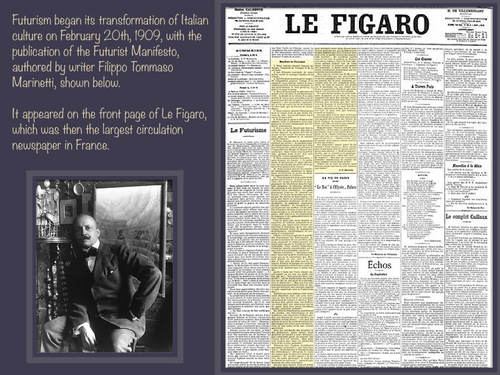












The author is a retired attorney but still a producing artist.
THERE ARE ACTUAL SLIDES ON THIS PAGE FOR YOUR REVIEW.
EXCERPT:
Futurism (Italian: Futurismo) was an artistic and social movement that originated in Italy in the early 20th century. It emphasized speed, technology, youth, and violence, and objects such as the car, the aeroplane, and the industrial city.
Started as Italian phenomenon but there were parallel movements in Russia, England, and elsewhere.
Futurism looks like an animated version of Cubism because of the “movement” which it gave its images. Cubism contributed to the formation of Italian Futurism's artistic style.
The Futurists did not like the Cubists’ focus on inanimate objects to be found in an art studio. They were interested in what was going on in life outside the art studio.
The machines of modern life, especially those with speed attached to them, such as trains and automobiles, attracted them.
While Cubists broke apart or “fractured” objects in their paintings, the Futurists fractured energy and motion.
The Futurists stuck to the colors of the Post Impressionists, which fairly leaped off the canvas, rather than going with the drab colors generally used by Cubists.
THERE ARE ACTUAL SLIDES ON THIS PAGE FOR YOUR REVIEW.
EXCERPT:
Futurism (Italian: Futurismo) was an artistic and social movement that originated in Italy in the early 20th century. It emphasized speed, technology, youth, and violence, and objects such as the car, the aeroplane, and the industrial city.
Started as Italian phenomenon but there were parallel movements in Russia, England, and elsewhere.
Futurism looks like an animated version of Cubism because of the “movement” which it gave its images. Cubism contributed to the formation of Italian Futurism's artistic style.
The Futurists did not like the Cubists’ focus on inanimate objects to be found in an art studio. They were interested in what was going on in life outside the art studio.
The machines of modern life, especially those with speed attached to them, such as trains and automobiles, attracted them.
While Cubists broke apart or “fractured” objects in their paintings, the Futurists fractured energy and motion.
The Futurists stuck to the colors of the Post Impressionists, which fairly leaped off the canvas, rather than going with the drab colors generally used by Cubists.
Something went wrong, please try again later.
This resource hasn't been reviewed yet
To ensure quality for our reviews, only customers who have purchased this resource can review it
Report this resourceto let us know if it violates our terms and conditions.
Our customer service team will review your report and will be in touch.
$5.00